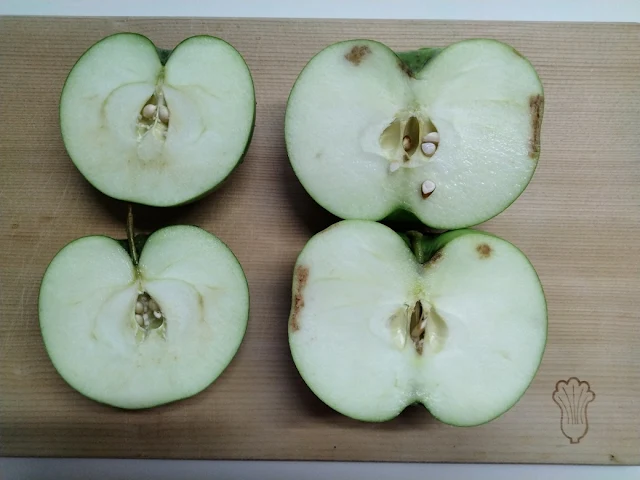昨日の雷雨と突風で、鉢植えリンゴ苗が両方とも 倒れていました。グラニースミスはその衝撃で実がもげてしまった! あと2か月は待って欲しかったのに。でも、見た目はイギリスで生食していたグラニースミスに劣らぬ大きさです。この色、この斑点、まさにGS。
We had lots of thunder and lightning yesterday and both of the potted apple trees were knocked down to the ground. The fruit on the Granny Smith tree came off in the rain and storm. I was hoping to keep it on the tree for another 2 months. However, the size of the fruit is already as large as those sold in stores in England for eating fresh.
「紅の夢」の苗を起こしてびっくり。実の表面にぽっかり黒い穴。赤く色づき始めたら野鳥に突かれるかもしれないと思い、ネット掛けにしてあったので虫の侵入ではないはず。最近の35℃超えの猛暑で焼けたようです。袋を掛けたあとは安心して観察を怠っていました。かなりショックですが、来年からは6月末頃か袋掛けにしようと思います。
The red-fleshed variety "Kurenai-no-Yume" was even worse. I had put a protective net on the fruit so that wild birds could not get to it, and yet, it had a large black hole! It turned out that the extreme summer heat and sun had burned a hole in it, and it had nothing to do with birds or insects.
ということで、もげたGSと剪定バサミで切り取った紅の夢。
Granny Smith on the left, and Kurenai-no-Yume on the right.
今年もウメボシの季節。よく行く八百屋さんで安い梅があったので2kg買ってきました。安かった理由は、かなり青い実だったから。塩漬けにして一月たった今も果肉が硬いです。実が固いのできっちり「3日干し」にしようと思います。
Ume plums have been pickled in salt for a month now and ready to be dried in the sum. This year, I bought 2 kg of them. After being sun-dried they are put back into the pickling pot with the red shiso leaves. They should be ready for eating from January onwards.








